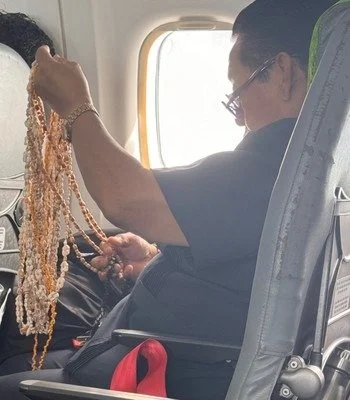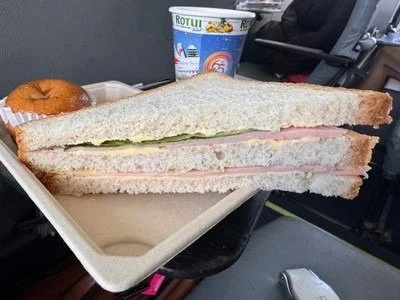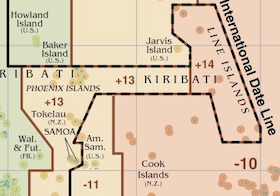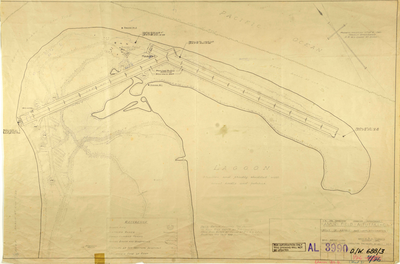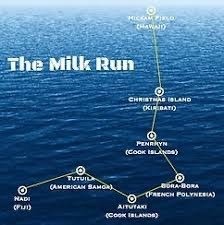Chapter 18: Fly to Cook Islands
Tahiti to Rarotonga to Aituaki
Today, I fly 8:40am-11:25am on Air Tahiti GZ35, Papeete PPT-Rarotonga RAR. Then, I wait for a bit over four hours and continue on another flight, this one to my final destination, the Aitutaki atoll. Compared to the very long flights from Orlando and then from Los Angeles, these are to be blissfully brief--but still just a bit less than three hours for the first and a bit under one hour for the second. The problem is with the lengthy layover in between. Air Rarotonga, the airline of the Cook Islands has flights departing to Rarotonga from Tahiti only on Wednesday and Saturday mornings. The airline's motto is "Kia Orana."
Kia Orana is more than just a tagline; it is a greeting. And, it is described as "the heart and soul of the Cook Islands." The tourism folks write: "This simple phrase encapsulates our people's spirit, our way of life, and our hopes for the future. Literally translated as "may you live long," Kia Orana is a heartfelt wish for a long and fulfilling life. It's a blessing, an expression of goodwill, and an invitation to connect on a deeper level. It is our desire to share this spirit with our visitors, inviting them to experience the Cook Islands way of life. By embracing Kia Orana, we hope to create a community where everyone thrives and our island home flourishes."
I admire an airline whose motto encourages me to live long.
The play by play is boringly simple. Up early, needing to leave the Hilton before the restaurant opens for my free breakfast, I linger in the lobby with a complimentary coffee and a WhatsApp call with B who is back in Kansas City.
A nice Australian fellow declined to share his cab to the airport so I gabbed another one—beating him to the airport by five minutes but costing us both half of the twenty dollar fare. I must have rubbed him the wrong way somehow.
Checking in with Air Tahiti for the Air Rarotonga codeshare fight was a challenge as the Air Tahiti check-in counter was hidden away on the far side of the open air terminal. The ATR aircraft is too small for me to keep my rollaboard with me so I hesitantly relinquished it to a ride in the luggage hold. That always worries me. Will it head for India?
There is no pre-check of course. Immigration was a lengthy, crowded, unfamiliar affair that took over an hour to complete. Do you remember when laptop computers had to be removed from backpacks, briefcases or carry-on bags? Well, in Tahiti, they not only have to be removed from any conveyance, they must also be turned on to prove that they are operable. So must your Kindle e-reader, Apple Watch and so must your iPhone.
The line was quite long due to two departing wide-body aircraft. An Air New Zealand Dreamliner was headed to Auckland and French Bee airlines (that I’ve never heard of that bills itself as a long-haul, low-cost carrier) had an A350 bound for San Francisco and then Paris. The Air France A350 I came in yesterday did not operate today, a Saturday, so the line was thankfully spared another 300 departing souls.
Watching people here is fascinating. First, departing family members were repeatedly hugged, cried over, draped with leis, flower hats, blossoms for their hair and multiple strands of huka shells. Babies were wept over and children enveloped by morbidly obese aunties. Men with facial tattoos openly shed tears whether they be the one departing or the one remaining. And nobody was dropped off by a single family member. Departures were truly family affairs with large groups accompanying everyone who would disappear behind the immigration counters. But even then, with only the tiniest gap through which to spy, vigorous waves were offered up by those headed to their flights. I’ve seen nothing like it.
Helzberg Diamonds would go broke here. Most local people are well adorned with decorative accessories but those consist of, first, extensive tattoos followed by flowers and then by many multiples of necklaces of shells. The only people wearing diamonds or pearls—the latter widely on sale here—were not locals.
About those Tahitian shell necklaces… They can also be made of flowers or stones and are often given to travelers. Often made of local cowries (small white mollusks) or turbos, a snail like shell. They are long, often hanging to the belt line and carry a spiritual or even religious meaning or, perhaps, symbolizing luxury. At the airport, each family member would present one as a sign of respect and honor as a way of saying goodbye or, better, “see you later.”
The Air Tahiti ATR was less than half full and, contrary to all the on-board literature which listed sandwiches for $7 and soft drinks for sale at $3.50 a pop—offered complimentary half-sandwiches. The carbohydrate content partially explains the typical body shape of Pacific Islanders and French Polynesians who are, by and large, rather big and large.
Wygovy would fail here because almost nobody, it would seem, aspires to be thin.
One other observation about Air Tahiti is that they know retail. Just after the triple-decker sandwich had been presented, they came round with a swag cart. Merchandise for sale incuded trucker caps at $16, pendants for $130, model aircraft for $40 and more including keychains, notebooks, travel pouches, water bottles and even luggage tags—free elsewhere—on sale here for $6 a pair.
Tahiti to Rarotonga, Cook Islands, is an international flight so there is paperwork to be completed during the journey. Among the questions on the Cook Islands Passenger Arrival Card to be answered was this one: “Have you ever been convicted of a criminal or immigration offense?” Prior to answering that question was this statement: “Warning: This Arrival Card is a legal document—false declarations can lead to penalties including confiscation of goods, fines, prosecution, imprisonment, and removal from Cook Islands.
Overleaf from that, there is this in the section marked TURANGA EVANGELIA “Respect for all people”: “In the Cook Islands, you get the chance to really connect with us locals. Show respect and kindness, and we’ll welcome you like family. Seek out experiences that support community initiatives, be considerate of our diverse beliefs and practices, and remember to dress modestly when driving around the island and when entering businesses.”
“Akaperepere ia to tatou parataito, kia vai ruperupe te reira.” (If you look after our little paradise, she will look after you) Welcome to the Cook Islands!
One thing learned aboard the flight from Tahiti to Rarotonga was that the New Zealand dollar is the official currency of the Cook Islands. ATM machines are located around the islands of Rarotonga an Aitutaki, including one located outside the arrival hall terminal. As a sign of what may be ahead was this statement: “Remember to also carry cash when visiting the outer islands.” Reading on, regarding activities and attractions, “Most operators are online, but some might need a good old-fashioned phone call.”
For emergencies our 911 is their 999.
Arrival at the Rarotonga International Airport, I find the opposite of yesterday's friendly Tahitian immigration agent. Quizzed about my proof of having already arranged for, and paid for, my departing flight a week from now, the officer was perhaps suspect I was a vagrant intent upon hiding out in the Cook Islands for whatever time I had left. The customs person wanted to know the last place my mask and snorkel had been in the water. “They’re new. Haven’t seen water yet,” I said. “Then you can go,” she said. I was indeed welcomed like family but in this case a dysfunctional one.
I have four hours to wait for my onward flight to Aitutaki. A bit of research reveals that there is a hotel bar across the road. I make my way to “The Islander” and take up residence on the windy deck adjacent to wandering hens and roosters to watch waves break 150 yards from the railing. A couple of Coronas and a fresh tuna bowl tide me over as I pen all of this.
The bad news is that my 4:00pm departure for Aitutaki is delayed for a bit over an hour to wait for passengers arriving in Rarotonga aboard an Air New Zealand flight from Auckland. No worries. the day was supposed to be devoted to travel and it turned out to be that and only that. It just gives me more time to write. Feel free to stop reading whenever boredom sets in.
This map, at a much different scale than the first two you saw, gives you a better idea of where Aitutaki (EYE two TOCKEY) actually is: east of Australia, northeast of New Zealand, and due east of the more well known islands of Samoa, Tonga and Fiji.
I appreciate that on no part of this journey must I cross the international date line--denoted on these maps by the weird dotted line. You can see how both French Polynesia (Tahiti) and the Cook Islands (Rarotonga and Aitutaki) are notched out to share a calendar day with the U.S. but not with the much closer nations of New Zealand and Australia as well as Japan and the rest of the far east.
Had I flown 750 miles more, I would have experienced a moment where it was 5:30pm on Saturday and, then, one second later, 5:30pm on Sunday. Mind blowing for me. You?
When one crosses the international date line, it is easy to get hotel reservations and flights booked on the wrong day--I have struggled with this point of confusion many times.
For an explanation of how this works, I quote from my favorite source: WikiPedia. "The 14th century Arab geographer Abulfeda predicted that circumnavigators would accumulate a one-day offset to the local date. This phenomenon was confirmed in 1522 at the end of the Magellan–Elcano expedition, the first successful circumnavigation. After sailing westward around the world from Spain, the expedition called at Cape Verde for provisions on Wednesday, 9 July 1522 (ship's time). However, the locals told them that it was actually Thursday, 10 July 1522. The crew was surprised, as they had recorded each day of the three-year journey without omission. Cardinal Gasparo Contarini, the Venetian ambassador to Spain, was the first European to give a correct explanation of the discrepancy."
To keep it simple, I will just say this. Where I am and where you are, it's the same day. Unless you are reading this in Auckland, Sydney, Tokyo or even relatively nearby Tonga or Samoa where it is precisely 24 hours from now: tomorrow. Got that?
The island of Aitutaki is, well, a dot of slightly less than seven square miles. Two thousand people live here, all with a fine view of Maunga Pu hill which rises 404 feet above sea level. Aitutaki is a peninsula island with a reef running along its eastern edge with many small islets along the east, south and southwestern borders. Many call the surrounding lagoon the most beautiful in the world. The main island--and 15 of the small islets--are volcanic. Most of the even smaller islets are coral and are called "motus." A couple of the very smallest ones are actually more sand than coral and are referred to as "sand cays." Around all of that is a barrier reef with the only safe routes through to the Pacific on the south and west sides. If entering from the west, one sails directly into the harbor of Arutanga, the main village on Aitutaki atoll.
The Amuri Field airstrip I flew in on was built during World War II by American contractors, Sverdrup and Parcel. 850 Americans joined with New Zealand forces stationed here in 1942, not long after the Japanese sneak attack on Pearl Harbor, 2,600 miles to the north of here. Autitaki was one of six Pacific islands chosen to form air routes—referred to as “The Milk Run” from Hawaii to Australia. When it appeared that the war would not extend this far south the U.S. force was cut to 12 men to keep the air field open and provided weather reports.
Aitutaki is served by Air Rarotonga Saab 340A 37-passenger and Embraer Bandeirante 18-passenger aircraft. The sign says, Aitutaki International Airport" but all the flights are, in point of fact, domestic to either Atiu Island or Rarotonga itself. I am met at the airport by Joshua, my whale host and Auntie Nonni from the Tamanu Beach Casual Luxury Hotel, my lodging for just this evening.
Lunch was so filling that I shall skip dinner tonight.



